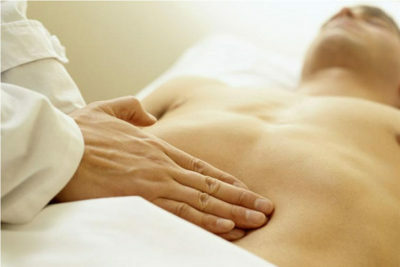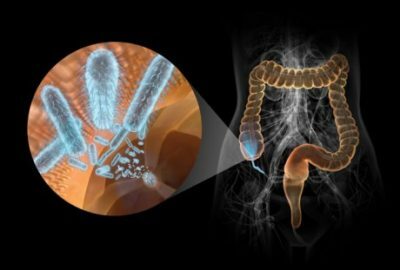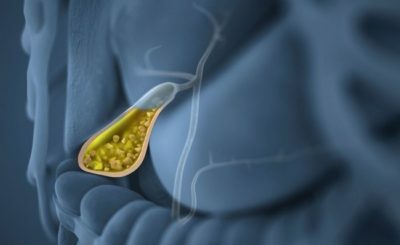1 Features of the
structure The length of the ileum in an adult is about 3 m. Its loops are compactly located in the right lower abdomen, which is called the right iliac fossa due to the fact that it lies in the ileal cavity. The ileum is completely covered with the peritoneum and has a mesentery, through which vessels and nerves come up to it. The presence of the mesentery makes the ileum loops moveable, which allows them to actively peristaltic and at the same time creates a danger of curvature of the intestine - acute obstruction due to the fact that the loops of the intestine overlap.
Do you have gastritis?
GALINA SAVINA: "How easy is it to cure gastritis at home for 1 month. A proven method - write down a recipe. ..!"Read more & gt; & gt;
The structure of the ileum wall corresponds to its function: digest and suck nutrients. The mucous membrane is collected in folds and crypts and covered with minute outgrowths - intestinal villi. These formations are covered with a cylindrical epithelium, under which there are blood capillaries and lymphatic sinuses - the places of the beginning of the lymphatic vessels, through which triglycerides from the intestine to the liver are transported with lymphal flow. The presence of these formations on the intestinal wall significantly increases the suction area. Compared with the jejunum in the ileum less villi.

We recommend that you familiarize yourself with the

Intestinal crypts are cavities in the mucosa that not only increase the suction area but also produce mucus that protects the intestinal wallfrom the influence of intestinal contents, and also are the primary link of local immunity.
Circular folds are formations that consist not only of the mucosa, but also of the submucosa. They cover the gut around the circumference, creating constrictions. The presence of these folds increases the surface area on which food is absorbed.
The muscular layer of the ileum is 2 layers of smooth muscle fibers, each of which is located in its direction. The inner circular layer provides periodic contractions and relaxation of the intestinal areas, mixing intestinal contents. Alternation of sites of contraction and relaxation of the small intestine allows food to mix with digestive enzymes. The longitudinal muscle layer is external. It creates peristaltic movements - waves of contractions that run along the entire intestine and move the chyme further along the digestive tract. Closer to the transition of the ileum into the blind, the thickness of the longitudinal muscle layer is reduced.
-
 IMPORTANT TO KNOW! Gastritis? Ulcer? To have a stomach ulcer not turned into cancer, drink a glass. ..Read the article & gt; & gt;
IMPORTANT TO KNOW! Gastritis? Ulcer? To have a stomach ulcer not turned into cancer, drink a glass. ..Read the article & gt; & gt;
The outer shell of the small intestine is the peritoneum, it covers the wall of the intestine from all sides, leaving a narrow lumen for the vessels and nerves - the mesentery, which allows the intestinal loops to retain mobility.
The contents of the ileum is called chyme and is a mushy mixture of almost completely digested food and digestive enzymes entering the intestines from the stomach, pancreas, liver and intestinal glands. The chemical reaction of chyme is slightly alkaline, and it is an unfavorable environment for intestinal wall cells, so they are covered with a protective layer of mucus. Violation of the integrity of this layer can lead to damage to the intestinal walls by active digestive enzymes.
The ileum connects to the blind, forming an ileocecal angle that serves as a reference for the surgeon during the appendix removal operation. Between the two divisions of the intestine are separated by a bougiania valve - the muscular valve, which strictly doses the contents of the small intestine that enters the large intestine. This is necessary so that the alkaline small intestine chyme does not violate the weakly acid medium of the large intestine and the vital activity of the bacteria that live in the caecum.
-
 Gastroenterologist. IMPORTANT: "I beg you, if you began to worry about abdominal pain, heartburn, nausea, do not do gas in any way. .."Read more & gt; & gt;
Gastroenterologist. IMPORTANT: "I beg you, if you began to worry about abdominal pain, heartburn, nausea, do not do gas in any way. .."Read more & gt; & gt;
2 Functions of the
department Like the entire thin, ileum, it performs 3 main functions:
- digestive enzyme release;
- digestion of food;
- absorption of nutrients.
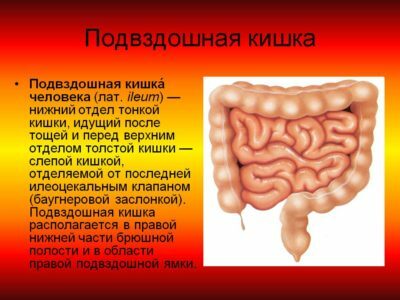
Intestinal juice of a slightly alkaline reaction is released in a relatively small amount( up to 2 liters per day).Its secretion is influenced by the presence of food in the intestines, stimulation of the nervous and endocrine system. In comparison with the intestinal juice of the jejunum and duodenum, the secret of the ileal mucosa is poor in enzymes and its relatively little.
Digestion in the small intestine occurs in 2 stages. Cavity digestion occurs in the gut lumen under the action of excreted enzymes. At this stage large molecules of proteins, complex lipids and starch are destroyed to smaller structural units: oligopeptides, disaccharides, monosaccharides and simple lipids. Pristenochnoe digestion occurs in the folds of the intestine, as well as on the surface of the cells of the epithelium released into the luminal cavity. Enzymes fixed on their surface provide the most complete cleavage of nutrients for amino acids, simple sugars and triglycerides, which can then be absorbed.
ADVICE FROM THE MAIN GASTROENTEROLOGIST
Korotov SV: "I can recommend only one remedy for the rapid treatment of Ulcer and Gastritis, which is now recommended by the Ministry of Health. .." Read testimonials & gt; & gt;
Absorption occurs on the surface of villi, with amino acids and monosaccharides entering the bloodstream, and lipids - into the lymphatic, where they are transported to the liver, connected to transport proteins in lipoproteins and only in this form enter the blood.

3 The most common diseases of
Symptoms of small bowel diseases are often combined under the general name of malabsorption syndrome, that is, insufficient absorption. This is done because the violation of only one of any functions does not happen almost never: as a rule, all three basic functions of the intestine are violated. Causes and treatment of malabsorption syndrome may be different: a violation of diet, hereditary factors, injuries, intoxications, infection, but the manifestations are very similar in nature.
Like any bowel disease, malabsorption syndrome manifests itself primarily in diarrhea. The chair at this time increases slightly, up to 4 times a day, but its consistency changes drastically. Stools become more fluid, but not as much as with diseases of the colon. Undigested food remains in the form of lumps. Their frequent companion - gases and rumbling in the intestines, more pronounced in the morning and less - in the afternoon.
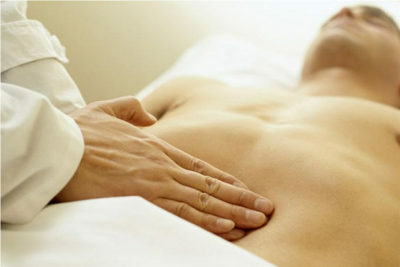
Abdominal pain is mainly localized in the right lower region, at the site of the intestine and near the navel. It is pressing, pulling, can change localization, appear and disappear. Often the expressed painful attack precedes defecation. Pain can be relieved after defecation or the escape of gases.
Absorption is manifested by loss of weight while maintaining the previous diet, poor health, impassable headaches and muscle weakness, reduced efficiency. Malabsorption syndrome often develops iron deficiency anemia and hypovitaminosis K. Their frequent signs are pale skin and mucous membranes, blurred vision, sores in the corners of the lips, brittle hair and nails, peeling of the skin, loss of appetite, apathy.
Vomiting occurs rarely, usually with eating, the taste and smell of which is unpleasant to the patient.
In infectious diseases accompanied by malabsorption syndrome, the temperature rises and symptoms of general intoxication appear.
If you have these symptoms, you need to see a doctor to determine their cause. As already mentioned above, the reasons can be very different, so prescribing treatment without knowing them is dangerous. Even before receiving the results of the tests, the doctor will recommend a sparing diet with a high content of easily digestible products: milk dishes, stewed or boiled low-fat meat and fish, mashed potatoes and various cereals. The diet can be adjusted after revealing the cause of malabsorption syndrome. Also, the doctor is likely to write out a sick list and, depending on the patient's condition, recommend outpatient treatment or hospitalization.
4 Additional Information
Malabsorption syndrome in severe form is rare, usually with infectious diseases of the small intestine. But its light and medium-heavy forms can last for years, then abating, then increasing and thus contributing to the disturbance of other body functions:
- digestion in the large intestine is disrupted;
- because of a lack of nutrients the work of the liver, bone marrow, nervous and endocrine systems suffers.
Patients with chronic malabsorption syndrome sleep poorly, their mood and performance are reduced. Over time, a whole bunch of concomitant diseases can develop.
- 1 Features of
- 2 structure Functions of
- 3 department Most common diseases
- 4 Additional information
The ileum is the third and last section of the small intestine. It is in the right ileum, above it is the jejunum, and the terminal ileum is connected to the blind - the first part of the large intestine. In this part of the intestine, most of the nutrients are digested and absorbed. Often the ileum and jejunum is treated together, since the structure and functions of these parts of the small intestine are very similar.

